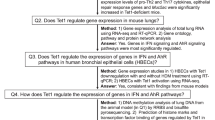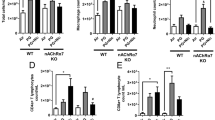Abstract
Chronic airway diseases, such as asthma and chronic obstructive pulmonary disease, are characterized by airway remodeling. Vascular endothelial growth factor (VEGF) is a critical regulator of angiogenesis and vascular remodeling, important components of airway remodeling. The aryl hydrocarbon receptor (AhR) is the principle receptor for many environmental toxicants, such as 2,3,7,8-tetrachlorodibenzo-p-dioxin (TCDD), which may contribute to the pathogenesis of asthma and chronic obstructive pulmonary disease. However, the regulatory role of AhR on the expression of VEGF in bronchial epithelial cells (BECs) remains elusive. This study was conducted to determine the role of AhR in regulating bronchial epithelial VEGF expression, which might contribute to angiogenesis of airway remodeling. The plasma VEGF levels of asthmatic patients and healthy subjects were compared. By treating HBE-135, Beas-2B, and primary human BECs with AhR agonists, the mechanisms through which AhR modulated VEGF expression in human BECs were investigated. The plasma VEGF level was significantly higher in asthmatic patients than in healthy subjects. AhR agonists significantly upregulated VEGF secretion from human BECs, which promoted the migratory and tube-forming ability of human umbilical vein endothelial cells. The secretion of VEGF was increased via a canonical AhR pathway, followed by the 15-LOX/15-HETE/STAT3 pathway. C57BL/6JNarl mice treated with TCDD intratracheally also showed increased VEGF expression in BECs. This hitherto unrecognized pathway may provide a potential target for the treatment of airway remodeling in many pulmonary diseases, especially those related to environmental toxicants.
Key message
-
AhR agonists increase VEGF secretion from bronchial epithelial cells.
-
The mechanism involves the canonical AhR pathway and 15-LOX/15-HETE/STAT3 pathway.
-
Asthmatic patients have higher plasma VEGF level.
-
Mice treated with intratracheal TCDD show increased VEGF expression in BECs.
-
This novel regulatory pathway is a potential target for treating asthma and COPD.






Similar content being viewed by others
References
Tsai MJ, Hsu YL, Wang TN, Wu LY, Lien CT, Hung CH, Kuo PL, Huang MS (2014) Aryl hydrocarbon receptor (AhR) agonists increase airway epithelial matrix metalloproteinase activity. J Mol Med 92:615–628
Chetta A, Olivieri D (2012) Role of inhaled steroids in vascular airway remodelling in asthma and COPD. Int J Endocrinol 2012:397693
Ma B, Dela Cruz CS, Hartl D, Kang MJ, Takyar S, Homer RJ, Lee CG, Elias JA (2011) RIG-like helicase innate immunity inhibits vascular endothelial growth factor tissue responses via a type I IFN-dependent mechanism. Am J Respir Crit Care Med 183:1322–1335
Takyar S, Vasavada H, Zhang JG, Ahangari F, Niu N, Liu Q, Lee CG, Cohn L, Elias JA (2013) VEGF controls lung Th2 inflammation via the miR-1-Mpl (myeloproliferative leukemia virus oncogene)-P-selectin axis. J Exp Med 210:1993–2010
Lee KY, Lee KS, Park SJ, Kim SR, Min KH, Choe YH, Lee YC (2008) Clinical significance of plasma and serum vascular endothelial growth factor in asthma. J Asthma 45:735–739
Valipour A, Schreder M, Wolzt M, Saliba S, Kapiotis S, Eickhoff P, Burghuber OC (2008) Circulating vascular endothelial growth factor and systemic inflammatory markers in patients with stable and exacerbated chronic obstructive pulmonary disease. Clin Sci (Lond) 115:225–232
Yoo Y, Choi IS, Byeon JH, Lee SM, La KS, Choi BM, Park SH, Choung JT (2010) Relationships of methacholine and adenosine monophosphate responsiveness with serum vascular endothelial growth factor in children with asthma. Ann Allergy Asthma Immunol 104:36–41
Kranenburg AR, de Boer WI, Alagappan VK, Sterk PJ, Sharma HS (2005) Enhanced bronchial expression of vascular endothelial growth factor and receptors (Flk-1 and Flt-1) in patients with chronic obstructive pulmonary disease. Thorax 60:106–113
Simpson A, Custovic A, Tepper R, Graves P, Stern DA, Jones M, Hankinson J, Curtin JA, Wu J, Blekic M et al (2012) Genetic variation in vascular endothelial growth factor-a and lung function. Am J Respir Crit Care Med 185:1197–1204
Balantic M, Rijavec M, Skerbinjek Kavalar M, Suskovic S, Silar M, Kosnik M, Korosec P (2012) Asthma treatment outcome in children is associated with vascular endothelial growth factor A (VEGFA) polymorphisms. Mol Diagn Ther 16:173–180
Yuksel H, Yilmaz O, Karaman M, Bagriyanik HA, Firinci F, Kiray M, Turkeli A, Karaman O (2013) Role of vascular endothelial growth factor antagonism on airway remodeling in asthma. Ann Allergy Asthma Immunol 110:150–155
Turner MC, Krewski D, Pope CA 3rd, Chen Y, Gapstur SM, Thun MJ (2011) Long-term ambient fine particulate matter air pollution and lung cancer in a large cohort of never-smokers. Am J Respir Crit Care Med 184:1374–1381
Hwang BF, Lee YL, Lin YC, Jaakkola JJ, Guo YL (2005) Traffic related air pollution as a determinant of asthma among Taiwanese school children. Thorax 60:467–473
Nishimura KK, Galanter JM, Roth LA, Oh SS, Thakur N, Nguyen EA, Thyne S, Farber HJ, Serebrisky D, Kumar R et al (2013) Early-life air pollution and asthma risk in minority children. The GALA II and SAGE II studies. Am J Respir Crit Care Med 188:309–318
Brunekreef B, Forsberg B (2005) Epidemiological evidence of effects of coarse airborne particles on health. Eur Respir J 26:309–318
Gao Y, Chan EY, Li L, Lau PW, Wong TW (2014) Chronic effects of ambient air pollution on respiratory morbidities among Chinese children: a cross-sectional study in Hong Kong. BMC Public Health 14:105
Sunyer J, Saez M, Murillo C, Castellsague J, Martinez F, Anto JM (1993) Air pollution and emergency room admissions for chronic obstructive pulmonary disease: a 5-year study. Am J Epidemiol 137:701–705
Makra L, Matyasovszky I, Balint B (2012) Association of allergic asthma emergency room visits with the main biological and chemical air pollutants. Sci Total Environ 432:288–296
Chiba T, Uchi H, Yasukawa F, Furue M (2011) Role of the arylhydrocarbon receptor in lung disease. Int Arch Allergy Immunol 155(Suppl 1):129–134
Wong PS, Vogel CF, Kokosinski K, Matsumura F (2010) Arylhydrocarbon receptor activation in NCI-H441 cells and C57BL/6 mice: possible mechanisms for lung dysfunction. Am J Respir Cell Mol Biol 42:210–217
Bertazzi PA, Consonni D, Bachetti S, Rubagotti M, Baccarelli A, Zocchetti C, Pesatori AC (2001) Health effects of dioxin exposure: a 20-year mortality study. Am J Epidemiol 153:1031–1044
Nguyen LP, Bradfield CA (2008) The search for endogenous activators of the aryl hydrocarbon receptor. Chem Res Toxicol 21:102–116
Henry EC, Bemis JC, Henry O, Kende AS, Gasiewicz TA (2006) A potential endogenous ligand for the aryl hydrocarbon receptor has potent agonist activity in vitro and in vivo. Arch Biochem Biophys 450:67–77
Hoshino M, Nakamura Y, Hamid QA (2001) Gene expression of vascular endothelial growth factor and its receptors and angiogenesis in bronchial asthma. J Allergy Clin Immunol 107:1034–1038
Zhao J, Maskrey B, Balzar S, Chibana K, Mustovich A, Hu H, Trudeau JB, O'Donnell V, Wenzel SE (2009) Interleukin-13-induced MUC5AC is regulated by 15-lipoxygenase 1 pathway in human bronchial epithelial cells. Am J Respir Crit Care Med 179:782–790
Singh NK, Wang D, Kundumani-Sridharan V, Van Quyen D, Niu J, Rao GN (2011) 15-Lipoxygenase-1-enhanced Src-Janus kinase 2-signal transducer and activator of transcription 3 stimulation and monocyte chemoattractant protein-1 expression require redox-sensitive activation of epidermal growth factor receptor in vascular wall remodeling. J Biol Chem 286:22478–22488
Bui P, Solaimani P, Wu X, Hankinson O (2012) 2,3,7,8-Tetrachlorodibenzo-p-dioxin treatment alters eicosanoid levels in several organs of the mouse in an aryl hydrocarbon receptor-dependent fashion. Toxicol Appl Pharmacol 259:143–151
Dong B, Matsumura F (2008) Roles of cytosolic phospholipase A2 and Src kinase in the early action of 2,3,7,8-tetrachlorodibenzo-p-dioxin through a nongenomic pathway in MCF10A cells. Mol Pharmacol 74:255–263
Takeuchi A, Takeuchi M, Oikawa K, Sonoda KH, Usui Y, Okunuki Y, Takeda A, Oshima Y, Yoshida K, Usui M et al (2009) Effects of dioxin on vascular endothelial growth factor (VEGF) production in the retina associated with choroidal neovascularization. Invest Ophthalmol Vis Sci 50:3410–3416
Roman AC, Carvajal-Gonzalez JM, Rico-Leo EM, Fernandez-Salguero PM (2009) Dioxin receptor deficiency impairs angiogenesis by a mechanism involving VEGF-A depletion in the endothelium and transforming growth factor-beta overexpression in the stroma. J Biol Chem 284:25135–25148
Wang TN, Lin MC, Wu CC, Leung SY, Huang MS, Chuang HY, Lee CH, Wu DC, Ho PS, Ko AM et al (2010) Risks of exposure to occupational asthmogens in atopic and nonatopic asthma: a case-control study in Taiwan. Am J Respir Crit Care Med 182:1369–1376
Sohn SW, Lee HS, Park HW, Chang YS, Kim YK, Cho SH, Kim YY, Min KU (2008) Evaluation of cytokine mRNA in induced sputum from patients with allergic rhinitis: relationship to airway hyperresponsiveness. Allergy 63:268–273
Forsythe JA, Jiang BH, Iyer NV, Agani F, Leung SW, Koos RD, Semenza GL (1996) Activation of vascular endothelial growth factor gene transcription by hypoxia-inducible factor 1. Mol Cell Biol 16:4604–4613
Ichihara S, Yamada Y, Ichihara G, Nakajima T, Li P, Kondo T, Gonzalez FJ, Murohara T (2007) A role for the aryl hydrocarbon receptor in regulation of ischemia-induced angiogenesis. Arterioscler Thromb Vasc Biol 27:1297–1304
Fritz WA, Lin TM, Peterson RE (2008) The aryl hydrocarbon receptor (AhR) inhibits vanadate-induced vascular endothelial growth factor (VEGF) production in TRAMP prostates. Carcinogenesis 29:1077–1082
Ma C, Li Y, Ma J, Liu Y, Li Q, Niu S, Shen Z, Zhang L, Pan Z, Zhu D (2011) Key role of 15-lipoxygenase/15-hydroxyeicosatetraenoic acid in pulmonary vascular remodeling and vascular angiogenesis associated with hypoxic pulmonary hypertension. Hypertension 58:679–688
Profita M, Sala A, Riccobono L, Paterno A, Mirabella A, Bonanno A, Guerrera D, Pace E, Bonsignore G, Bousquet J et al (2000) 15-Lipoxygenase expression and 15(S)-hydroxyeicoisatetraenoic acid release and reincorporation in induced sputum of asthmatic subjects. J Allergy Clin Immunol 105:711–716
Pages G, Pouyssegur J (2005) Transcriptional regulation of the vascular endothelial growth factor gene–a concert of activating factors. Cardiovasc Res 65:564–573
Niu G, Wright KL, Huang M, Song L, Haura E, Turkson J, Zhang S, Wang T, Sinibaldi D, Coppola D et al (2002) Constitutive Stat3 activity up-regulates VEGF expression and tumor angiogenesis. Oncogene 21:2000–2008
Xu B, Bhattacharjee A, Roy B, Xu HM, Anthony D, Frank DA, Feldman GM, Cathcart MK (2003) Interleukin-13 induction of 15-lipoxygenase gene expression requires p38 mitogen-activated protein kinase-mediated serine 727 phosphorylation of Stat1 and Stat3. Mol Cell Biol 23:3918–3928
Funding
This study was supported by grants from the Kaohsiung Medical University Hospital (KMUH101-1M12, KMUH102-2T06 and KMUH102-2M07), the Aim for the Top Journals Grant, Kaohsiung Medical University Research Foundation (KMU-DT103008), National Science Council (NSC 101-2320-B-037-043-MY3), and Ministry of Science and Technology (MOST 104-2314-B-037-005).
Conflict of interest
The authors declare no conflicts of interest.
Author information
Authors and Affiliations
Corresponding authors
Additional information
Ya-Ling Hsu and Ming-Shyan Huang contributed equally to this work.
Electronic supplementary material
Below is the link to the electronic supplementary material.
ESM 1
(PDF 340 kb)
Rights and permissions
About this article
Cite this article
Tsai, MJ., Wang, TN., Lin, YS. et al. Aryl hydrocarbon receptor agonists upregulate VEGF secretion from bronchial epithelial cells. J Mol Med 93, 1257–1269 (2015). https://doi.org/10.1007/s00109-015-1304-0
Received:
Revised:
Accepted:
Published:
Issue Date:
DOI: https://doi.org/10.1007/s00109-015-1304-0




